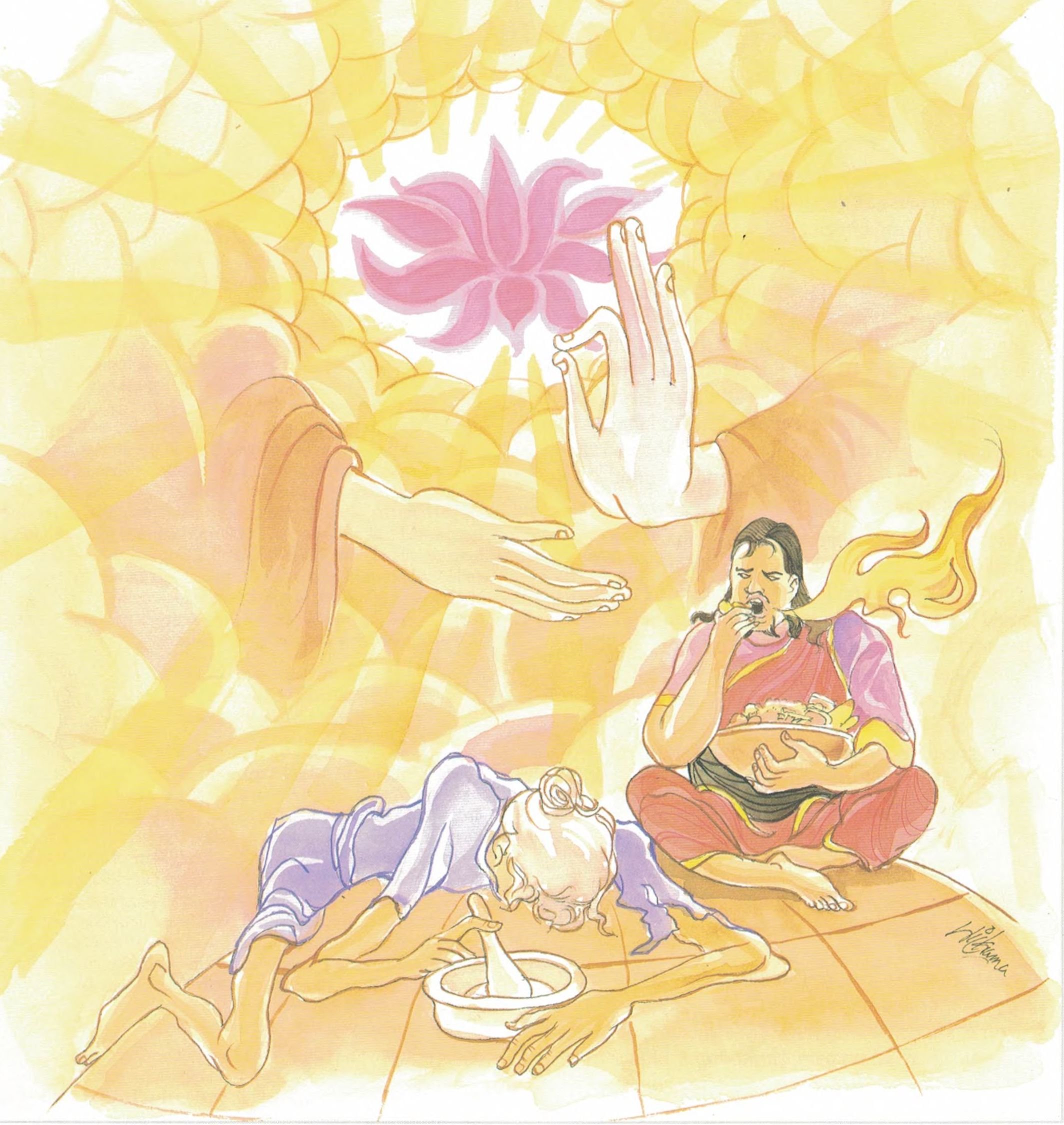Dhammapada (Illustrated)
by Ven. Weagoda Sarada Maha Thero | 1993 | 341,201 words | ISBN-10: 9810049382 | ISBN-13: 9789810049386
This page describes The Story of a Lay-Disciple which is verse 203 of the English translation of the Dhammapada which forms a part of the Sutta Pitaka of the Buddhist canon of literature. Presenting the fundamental basics of the Buddhist way of life, the Dhammapada is a collection of 423 stanzas. This verse 203 is part of the Sukha Vagga (Happiness) and the moral of the story is “Hunger’s the severest ailment. Samsaric life’s an utter dismay. Beyond these is Nibbana bliss”.
Verse 203 - The Story of a Lay-Disciple
Pali text, illustration and English translation of Dhammapada verse 203:
jighacchāparamā rogā saṅkhāra paramā dukhā |
etaṃ ñatvā yathābhūtaṃ nibbāṇaṃ paramaṃ sukhaṃ || 203 ||
203. Hunger is the greatest ill, the greatest dukkha—conditionedness, knowing this really as it is: Nibbāna bliss supreme.
 Hunger’s the severest ailment. Samsaric life’s an utter dismay. Beyond these is Nibbāna bliss. |
The Story of a Lay-Disciple
The Buddha spoke this verse at the village of Ālavi, with reference to a lay-disciple.
One day, the Buddha saw in his vision that a poor man would attain sotāpatti fruition at the village of Ālavi. So he went to that village, which was thirty yojanas (leagues) away from Sāvatthi. It so happened that on that very day the man lost his oxen. So, he had to be looking for the oxen. Meanwhile, almsfood was being offered to the Buddha and his disciples in a house in the village of Ālavi. After the meal, people got ready to listen to the Buddha’s discourse;but the Buddha waited for the young man. Finally, having found his oxen, the man came running to the house where the Buddha was. The man was tired and hungry, so the Buddha directed the donors to offer food to him. Only when the man had been fed, the Buddha gave a discourse, expounding the Dhamma step by step and finally leading to the Four Noble Truths. The lay-disciple attained sotāpatti fruition at the end of the discourse.
Afterwards, the Buddha and his disciples returned to the Jetavana Monastery. On the way, the monks remarked that it was so surprising that the Buddha should have waited and directed those people to feed the young man before he gave the discourse. On hearing their remarks, the Buddha said, “Monks! What you said is true, but you do not understand that I have come here, all this distance of thirty yojanas, because I knew that he was in a fitting condition to take in the Dhamma. If he were feeling very hungry, the pangs of hunger might have prevented him from taking in the Dhamma fully. That man had been out looking for his oxen the whole morning, and was very tired and also very hungry. Monks! After all, there is no ailment which is so difficult to bear as hunger.”
Explanatory Translation (Verse 203)
rogā jighacchā paramā dukhā sankhārā paramā
etaṃ yathābhūthaṃ ñatvā nibbānaṃ paramaṃ sukhaṃ
rogā: of diseases; jighacchā paramā: hunger is the worst; dukhā: of pains; sankhārā paramā: component are the worst; etaṃ: these; yathābhūthaṃ [yathābhūtha]: (when) realistically; ñatvā: understood; nibbānaṃ [nibbāna]: Deathlessness; paramaṃ sukhaṃ [sukha]: is the highest bliss
The most severe of diseases is hunger. The worst of pain is in component things. If this is realistically appreciated, Nibbāna is the highest bliss.
Commentary and exegetical material (Verse 203)
sankhārā paramā dukhā: components (sankhārā) the worst suffering. The term sankhārā has different shades of meaning, which should be carefully distinguished. To its most frequent usages the general term formation may be applied, with the qualifications required by the context. This term may refer either to the act of forming or to the passive state of having been formed or to both.
(1) As the second link of the formula of dependent origination, (paticca-samuppāda), sankhāra has the active aspect, forming, and signifies Kamma which is wholesome or unwholesome volitional activity (cetanā) of body (kāya), speech (vacī) or mind (citta or mano). For, in this sense, the word ‘Karma-formation’ has been coined by the author. In other passages, in the same context, sankhārā is defined by reference to (a) meritorious Karma-formations (puññābhisankhāra), (b) demeritorious (apuññābhisankhāra), (c) imperturbable (āneñjābhisankhāra). This three-fold division covers kammic activity in all spheres of existence: the meritorious kamma-formations extend to the sensuous and the fine-material sphere, the demeritorious ones only to the sensuous sphere, and the imperturbable only to the immaterial sphere.
(2) The aforementioned three terms, kāya-, vacī- and citta (or mano), are sometimes used in quite a different sense, namely as (a) bodily function as in-and-out-breathing; (b) verbal function as thought-conception and discursive thinking; and (c) mental function as feeling, perception.
(3) It also denotes the fourth group of existence (sankhāra-kkhandha), and includes all mental formations whether they belong to kammically forming consciousness or not.
(4) It occurs further in the sense of anything formed (sankhata) and conditioned, and includes all things whatever in the world, all phenomena of existence. This meaning applies to the well-known passage “All formations are impermanent… subject to suffering” (sabbe sankhārā aniccā… dukkhā). In that context, however, sankhārā is subordinate to the still wider and all-embracing term dhamma (thing); for dhamma includes also the unformed or unconditioned element (asankhata-dhātu), i.e., Nibbāna (e.g., in sabbe dhammā anattā: all things are without a self).
Sankhārā also means ‘volitional effort’, e.g., in the formula of the Roads to Power (iddhi-pāda);in sasankhārā- and asankhāra-parinibbāyi (anāgāmī); and in the Abhidhamma terms asankhārika and sasankhārika-citta, i.e., without effort–spontaneously, and with effort–prompted.
Within the dependent origination, sankhārā is neither subconscious nor a mere tendency, but is a fully conscious and active karmic volition. In the context of the five groups of existence, a very few of the factors from the group of mental formations (sankhāra-kkhandha) are also present as concomitants of sub-consciousness, but are not restricted to it, nor are they mere tendencies.
